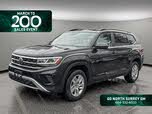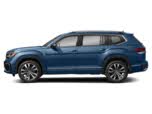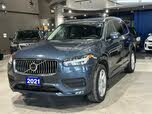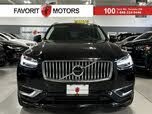2021 Volkswagen Atlas vs 2021 Volvo XC90
Overview | ||
MSRP | $31,545 | $49,000 |
Average price | $33,815 | $43,808 |
Listings | ||
Ratings & Reviews | ||
User reviews | ||
Expert reviews | 6.5 out of 10Read full review | 7.7 out of 10Read full review |
Pros & cons | ||
Summary | Introduced for the 2018 model year, the Volkswagen Atlas is the automaker's latest attempt to win over North American buyers. Built in Chattanooga, Tennessee, the VW Atlas competes in the three-row crossover SUV segment against well-established nameplates like the Ford Explorer, Honda Pilot, and Toyota Highlander. Changes for 2021 are limited to exterior styling tweaks and a reshuffled option list. VW also offers the two-row Volkswagen Atlas Cross Sport. | Volvo may be known for sensible station wagons, but the XC90 SUV is the Swedish automaker’s de facto flagship. The current generation debuted design features, technology, and powertrains that have since found their way into most other Volvo models. Several years into the current-generation model’s lifecycle, the XC90 is no longer a trendsetter, but remains Volvo’s contender in the competitive midsize luxury SUV segment, with the automaker’s typical emphasis on safety features. The current-generation XC90 launched for the 2016 model year, so most competitors—including the Audi Q7, Acura MDX, BMW X5, and Mercedes-Benz GLE—have been updated or redesigned since then. The Cadillac XT6 and Lincoln Aviator didn’t even exist when this generation of XC90 launched. A redesigned version is expected to arrive soon, so changes to the 2021 XC90 are minimal. All 2021 Volvo models are now limited to 180 kilometres per hour for safety reasons. The XC90 also gets a handful of newly standard tech features, and some small cosmetic changes. Volvo offers the XC90 in three trim levels—Momentum, R-Design, and Inscription—with three powertrain options: T5 and T6 gasoline engines, and the T8 plug-in hybrid. Our test car was a range-topping T8 Recharge Inscription, combining the top Inscription trim level with the plug-in hybrid powertrain, which has the highest output of the three. |
Video | No video found | |
Popular Features & Specs | ||
Engine | 2.0L 235 hp I4 | 2.0L 250 hp I4 |
Drive Train | FWD | FWD |
Seating Capacity | 7 | 7 |
Horsepower | 250 hp @ 5500 rpm | |
MPG City | 21 | 21 |
MPG Highway | 24 | 30 |
Engine | ||
Engine Name | 2.0L 235 hp I4 | 2.0L 250 hp I4 |
Torque | 258 lb-ft @ 1500 rpm | |
Horsepower | 250 hp @ 5500 rpm | |
Drivetrain | FWD | FWD |
Fuel Economy | ||
MPG City | 21 | 21 |
MPG Highway | 24 | 30 |
Interior | ||
Seating Capacity | 7 | 7 |
Key Features | ||
Sunroof/Moonroof | Standard | |
Safety | ||
Front Crash Overall | 4 | 5 |
Side Crash Overall | 5 | 5 |
Dimensions & Capacity | ||
Cargo Space | 20.6 cu ft | 15.8 cu ft |
Curb Weight | 4248 lbs | 4374 lbs |
Height | 70.1 in | 69.9 in |
Length | 200.7 in | 195.0 in |
Width | 78.4 in | 84.3 in |
Wheelbase | 117.3 in | 117.5 in |
Maximum Payload | 1080 lbs | 1631 lbs |
Number of doors | 4 | 4 |
Maximum Towing Capacity | 2000 lbs | 4000 lbs |
The 2021 Volkswagen Atlas underwent a styling refresh that included new front and rear bumpers, standard LED headlights and taillights, and a new grille design, which added 6 centimetres to its length. This gave the Atlas a more extroverted appearance compared to its 2020 predecessor, although some elements like the fake chrome exhaust tips were considered a bit over the top. The R-Line trim package further enhanced its sporty look with unique bumpers and side skirts. Despite these cosmetic changes, the Atlas retained its MQB platform, shared with other VW models like the Jetta and Golf, showcasing its versatility. The interior followed a minimalist approach, with a standard seven-seat configuration and options for second-row captain’s chairs. However, the material quality was noted to be below average, with cheap-feeling plastics and faux wood and metal trim.
The 2021 Volvo XC90, on the other hand, successfully reshaped Volvo's image with its design, maintaining traditional styling features like a boxy profile and rectangular grille while adding character with softer lines and distinctive LED headlights. The Inscription trim, with its extra chrome and optional 21-inch wheels, was the flashiest, while the R-Design offered a sportier look. Built on Volvo's Scalable Product Architecture, the XC90 shared its platform with other Volvo models, ensuring a cohesive design language. Inside, the XC90 embraced Swedish minimalism with high-quality materials and thoughtful arrangement. The interior featured matte-finish wood trim and unique upholstery options like wool, alongside luxurious touches such as an Orrefors crystal shifter. The overall design was restrained yet elegant, providing a sense of luxury without overwhelming the senses.
The 2021 Volkswagen Atlas offered two engine options: a standard 2.0-litre turbocharged inline-four producing 235 horsepower and 258 pound-feet of torque, and a 3.6-litre VR6 engine with 276 hp and 266 lb-ft. Both engines were paired with an eight-speed automatic transmission and standard 4Motion all-wheel drive. The 4Motion system could switch to front-wheel drive under low load to save fuel. However, the driving experience with the base engine was underwhelming, with adequate acceleration but rough shifts and poor ride quality. The Atlas had a towing capacity of 2,267 kilograms with the VR6 engine, but only 900 kilograms with the four-cylinder engine. Fuel efficiency was not impressive, with the four-cylinder models rated at 10.9 litres per 100 kilometres combined and VR6 models at 12.9 litres per 100 kilometres combined.
The 2021 Volvo XC90 featured three powertrains, all based on a 2.0-litre four-cylinder engine and eight-speed automatic transmission. The base T5 engine was turbocharged, producing 250 hp and 258 lb-ft of torque, while the T6 added supercharging for 316 hp and 295 lb-ft. The T8 Twin Engine plug-in hybrid combined the T6 engine with electric assist, delivering 400 hp and 472 lb-ft. All models came with standard all-wheel drive. Despite the impressive power output, the XC90's small engine struggled with flexibility compared to competitors' six-cylinder or V8 engines. The XC90 offered three drive modes—Pure, Hybrid, and Power—but the Pure mode was limited to low speeds. The XC90 excelled in ride quality, thanks to an optional air-suspension system, and maintained a quiet cabin. It had a towing capacity of 2,250 kilograms, comparable to the Atlas.
The 2021 Volkswagen Atlas was designed as a family hauler, offering three rows of seating with a standard seven-seat configuration. It provided 2,741 litres of cargo space behind the front seats and 583 litres with all seats up. While it offered more third-row legroom than most competitors, it sacrificed second-row legroom, which was the worst among its peers. The second-row bench seat was uncomfortable, with thin cushions. The Atlas featured a user-friendly layout with controls within easy reach, up to five USB ports, and a wireless charging pad. It also boasted up to 17 cupholders. However, forward visibility was less than optimal, and parking assistance features were available on higher trims.
The 2021 Volvo XC90 offered six-seat or seven-seat configurations, with headroom and legroom about average for the segment. The third-row space was tight for adults, and the seats lacked support. An optional power sunroof and standard four-zone climate control enhanced the interior's spacious feel. The Inscription trim featured 10-way power-adjustable heated and ventilated front seats with massage, but lacked a power-adjustable steering wheel. Cargo space was limited, with 317 litres with all seats in place, 965 litres with the rear seats folded, and 1,815 litres with the second and third rows folded. The XC90 included a hands-free power tailgate for convenience.
The 2021 Volkswagen Atlas came with Bluetooth and Apple CarPlay/Android Auto compatibility. The base trim had a 6.5-inch touchscreen, while other models featured an 8-inch screen with satellite radio. Higher trims offered Volkswagen’s Digital Cockpit, replacing analog gauges with a 10.3-inch digital display. The Atlas was set to receive VW’s new MIBIII infotainment system later in the year, adding multi-phone pairing and improved voice recognition. The base audio system was decent, with a 12-speaker Fender audio system available on the Execline trim.
The 2021 Volvo XC90 featured the Sensus infotainment system with a 9-inch touchscreen, 12.3-inch digital instrument cluster, and Apple CarPlay/Android Auto compatibility. It included two front USB-A ports and two rear USB-C ports. A 19-speaker Bowers & Wilkins audio system and head-up display were available. The portrait-oriented touchscreen was user-friendly, though the text was difficult to read while driving. The wireless charging pad was too small for most phones, and only second-row USB-C ports were available.
The 2021 Volkswagen Atlas received a top “good” rating in all IIHS crash tests, with a “marginal” rating for child-seat anchors and mixed headlight ratings. The NHTSA hadn’t published ratings for the 2021 model, but the 2020 model received a five-star overall rating. Standard safety features included automatic emergency braking and blind-spot monitoring, with adaptive cruise control and lane-keep assist available on higher trims. The Atlas was set to receive more advanced driver aids later in the year.
The 2021 Volvo XC90 earned the highest “Top Safety Pick+” rating from the IIHS for non-hybrid models, with top “Good” scores in all crash tests. It received a “Superior” rating for front-crash prevention in vehicle-to-vehicle testing and an “Advanced” rating in vehicle-to-pedestrian testing. The NHTSA gave all XC90 models a five-star overall safety rating. The XC90 offered a comprehensive suite of standard safety features, including lane-keep assist, blind-spot monitoring, and adaptive cruise control.
CarGurus highlights

According to CarGurus experts, the overall rating for 2021 Volkswagen Atlas is 6.5 out of 10, while the 2021 Volvo XC90 scores 7.7 out of 10. Based on these ratings, the 2021 Volvo XC90 is the recommended choice, offering a more luxurious interior, better safety features, and a higher overall rating.
Choose the 2021 Volkswagen Atlas if:
Shop Now- You prioritize a spacious third row and ample cargo space for family trips.
- You prefer a straightforward, user-friendly interior layout with plenty of cupholders and USB ports.
- You want a vehicle with a strong towing capacity and standard all-wheel drive.
Choose the 2021 Volvo XC90 if:
Shop Now- You value a luxurious, minimalist interior with high-quality materials and unique design touches.
- You seek a comprehensive suite of standard safety features and top safety ratings.
- You desire a plug-in hybrid option for improved efficiency and reduced emissions.

By: CarGurus + AI
At CarGurus, our team of experienced automotive writers remain at the heart of our content operation, conducting hands-on car tests and writing insightful guides that are backed by years of industry experience. To complement this, we are harnessing AI to make our content offering more diverse and more helpful to shoppers than ever. To achieve this, our AI systems are based exclusively on CarGurus content, ratings and data, so that what we produce is both unique to CarGurus, and uniquely helpful to car shoppers.






































